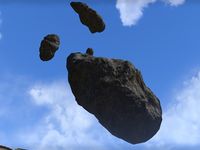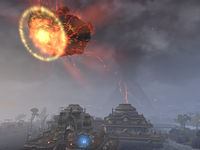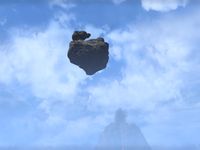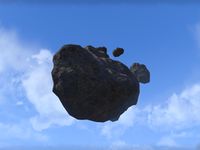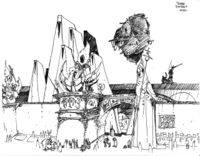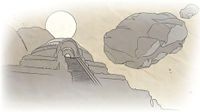Lore:Baar Dau
| Baar Dau | |
|---|---|
| Type | Celestial Rock |
| Continent | Tamriel |
| Province | Morrowind |
| Region | Vvardenfell (Ascadian Isles) |
| Settlement | Vivec City |
| Appears in | Morrowind, ESO |
Baar Dau[1] (also known as the Ministry of Truth,[2] Prison Moon,[3] or Lie Rock[4]) was a meteor, celestial rock or moonlet which hovered above Vivec City in southern Vvardenfell.[5] According to the prevailing legends, it was flung from the Void by either Sheogorath[1][6] or its own malevolence,[4] but was prevented from crashing into the city by the Tribunal god Vivec. Vivec allowed it to remain looming above the city so that if its people ever ceased to love him, the rock would fall and destroy them.[4] Other lesser-known tales and theories vary widely as to Baar Dau's origins, with one identifying it as a former Magna Ge named Una, another insisting that it was an egg from which would one day emerge the nightmarish offspring of Vivec and Molag Bal, and yet another claiming that it was Malacath's dung.[7]
Mythology and Origins[edit]
Book of Hours[edit]
Sermon 33 from Vivec's series The Thirty-Six Lessons of Vivec provides an account of an encounter with Baar Dau, referred to within the story as Lie Rock. In the sermon, Lie Rock is one of Vivec's eight Monster Children who initally escaped being slain, the result of the marriage of Vivec and Molag Bal, the Pomegranate Banquet, in a previous sermon.[8] Lie Rock "was born of Vivec's second aperture", meaning it was dung excreted from Vivec.[UOL 1] Lie Rock was removed from the Pomegranate Banquet from a forgotten guild known as the Sweeps. Lie Rock escaped the clutches of the Sweeps and ascended to the heavens claiming his divine parentage made him invited into the Hidden Heaven. This Hidden Heaven realm was known as the Scaled Blanket, and housed the Void Ghost. Vivec sent Nerevar to the heavens with the named axe to shave Lie Rock asunder but the Hortator only encountered the Void Ghost. Lie Rock used this distraction to launch an attack on the city-god Vivec. The inhabitants of Vivec City screamed in terror as they saw the shooting star hurling towards the city out of the sky but Vivec merely raised his hand, froze Lie Rock right above the city and pierced it with Muatra.[4]
When Nerevar returned, he asked if Lie Rock should be removed. Vivec responded: "I would have done so myself if I wanted, silly Hortator. I shall keep it there with its last intention intact, so that if the love of the people of this city for me ever disappear, so shall the power that holds back their destruction."[4]
Nerevar's response to this, "Love is under your will only", pleased Vivec, and he informed Nerevar that he had become a Minister of Truth.[4] Notably, the Ministry of Truth was the name used for the installation built inside Baar Dau.[9]
Alternate Tales[edit]
Various other tales for the celestial rock exists such as it being flung from the heavens by the Mad God Sheogorath who was bored and wished to destroy Vivec City as the Daedric Prince felt the city was built in mockery of the heavens. Citizens of Tamriel prayed unanswered prayers to the Divines and Daedric Princes alike to stop the rock's fall but only the prayers to the blessed Living Gods were heard. Vivec raised his hand and stopped the descent of the moonlet. Baar Dau itself pledged eternal servitude to the Tribunal thereafter; it guarded over the palace of Vivec and served as a citadel for the Ordinators.[1][6]
Another account claimed it was a Magna Ge named Una. Una became separated from her kin as they fled to Aetherius and so Una instead chose companionship with Nirn and chose to nestle in close in Vvardenfell, right above Vivec City where neither Una nor Nirn would feel alone again.[7]
One Orcish tale claims Baar Dau is not the dung of Vivec as the sermons claim, but rather the dung of Malacath. As Vivec had said something about Ogres that angered Malacath,[7] and had also done battle with the Flute-and-Pipe Ogres of the West Gash,[10] the Daedric Prince defecated on the city of the Living God for the disrespect to Malacath's beloved "little brothers".
Yet another scholarly account claimed that Baar Dau was not a rock, but rather an egg. Specifically, the chrysalis from which would one day hatch the final monster of Vivec and Molag Bal's ill-fated union that Vivec would engage in glorious battle with.[7]
History[edit]
Vivec's Palace had existed for milennia before the rest of the city,[11] attracting pilgrims and wanderers to come visit the poet, including Baar Dau. The display of Baar Dau as a wonder of the city inspired even more pilgrims to come visit.[UOL 2] Baar Dau originally rested higher in the sky, but plunged dramatically in 2E 582, when Vivec's power was temporarily drained. The moonlet remained aloft only tenuously, showering Vivec City with burning fragments. After Vivec regained his power, he kept Baar Dau in its new position, just above the High Fane of the Temple Canton.[12] Some time later, Baar Dau was hollowed out by the Tribunal Temple and became the Ministry of Truth, where the Temple would imprison dissident priests and attempt to reform them.[2] The high-security prison was accessible only through levitation, and was directed by a Grand Inquisitor who, per tradition, wore a ring fortified with great enchantments.[13] The main areas were the Hall of Processing and the Prison Keep. Temple pilgrims offered levitation potions at the Shrine of Daring, which was dedicated to Vivec stopping the moon from destroying the city.[2]
Early in the Fourth Era, after the disappearance of Vivec, the magic keeping Baar Dau afloat began to weaken. Two Dunmer, Sul and Vuhon, created an ingenium, a soul-powered device which supported the rock.[14] It was created by making a pact with Clavicus Vile, who had a penchant for souls. The Ingenium was used to create a rift to the Fields of Regret through which souls were funneled to Clavicus Vile and the energies of the realm were leeched to hold the moon in place. The mage Sul, who was one of the designers of Ingenium, theorized that the Daedric Prince did not care for the stolen energies as he valued the souls he received in exchange more, and that the other architect of the project, Vuhon, might have even made a formal pact with Vile for him to allow the energies to be taken.[15] Hundreds of captured souls were needed to run the machine, but eventually living people were used. Only the people with the strongest souls were sacrificed. Ilzheven, Sul's love, was sacrificed by Vuhon, and the ingenium was destroyed when Sul attempted to rescue her. In 4E 5, without anything holding it up, Baar Dau resumed its long-delayed fall, returning to the momentum it had before being halted. This obliterated the city of Vivec, leaving a crater which would become Scathing Bay. In turn, the impact created tsunamis which ravaged mainland Morrowind and caused Red Mountain to erupt, devastating Vvardenfell.[14] The disaster of the Red Year effectively ended the ascendancy of the Tribunal Temple and the mainstream worship of the Tribunal as gods.[16]
Gallery[edit]
Notes[edit]
- Dunmer jailmasters wear Jailmaster Rings to honor their predecessors, including those who perished when the Ministry of Truth came crashing down.[17]
- Una the Magna Ge shares name with Una the Green Elk, a lesser Druidic spirit.[18][19] Any form of connection between Una the Green Elk and Una the Magna Ge is unknown.
See Also[edit]
- For game-specific information, see the Morrowind article.
References[edit]
- ^ a b c The Pilgrim's Path — Tribunal Temple
- ^ a b c Events of Morrowind
- ^ Vivec's Palace concept art
- ^ a b c d e f 36 Lessons of Vivec, Sermon 33 — Vivec
- ^ Guide to Vivec
- ^ a b A Tale of Baar Dau — Amili Drals, Pedagogue
- ^ a b c d Testimonials on Baar Dau — Minerva Calo, Associate Chronicler
- ^ 36 Lessons of Vivec, Sermon 12 — Vivec
- ^ Ministry of Truth in Morrowind
- ^ 36 Lessons of Vivec, Sermon 31 — Vivec
- ^ On Moving Ebonheart — Archcanon Tarvus
- ^ Events of ESO
- ^ Grand Inquisitor's Ring item in Blades
- ^ a b The Infernal City — Greg Keyes
- ^ Pages 257-258 of The Infernal City
- ^ The Reclamations — Thara of Rihad
- ^ Jailmaster's Ring description in Blades
- ^ Una the Green Elk Figurine item description in ESO: High Isle
- ^ Painted Elk Clay Pot antiquity codex entry in ESO: High Isle
Note: The following references are considered to be unofficial sources. They are included to round off this article and may not be authoritative or conclusive.
|
||||||||
|
|||||||||||||||||||||||

